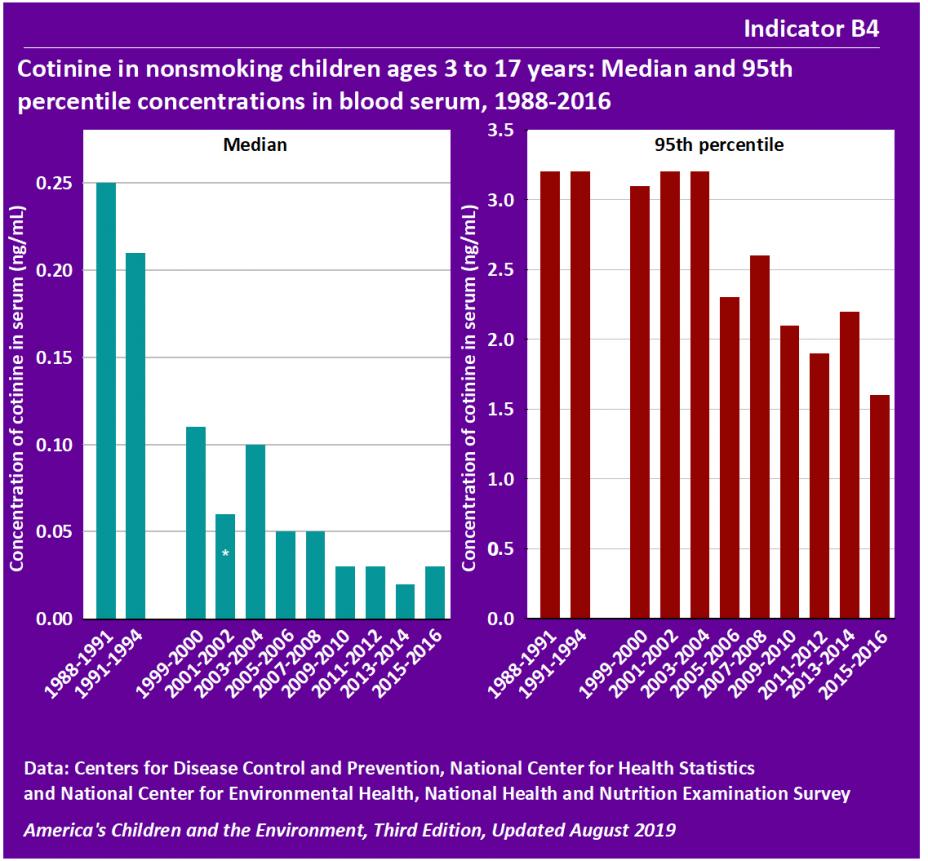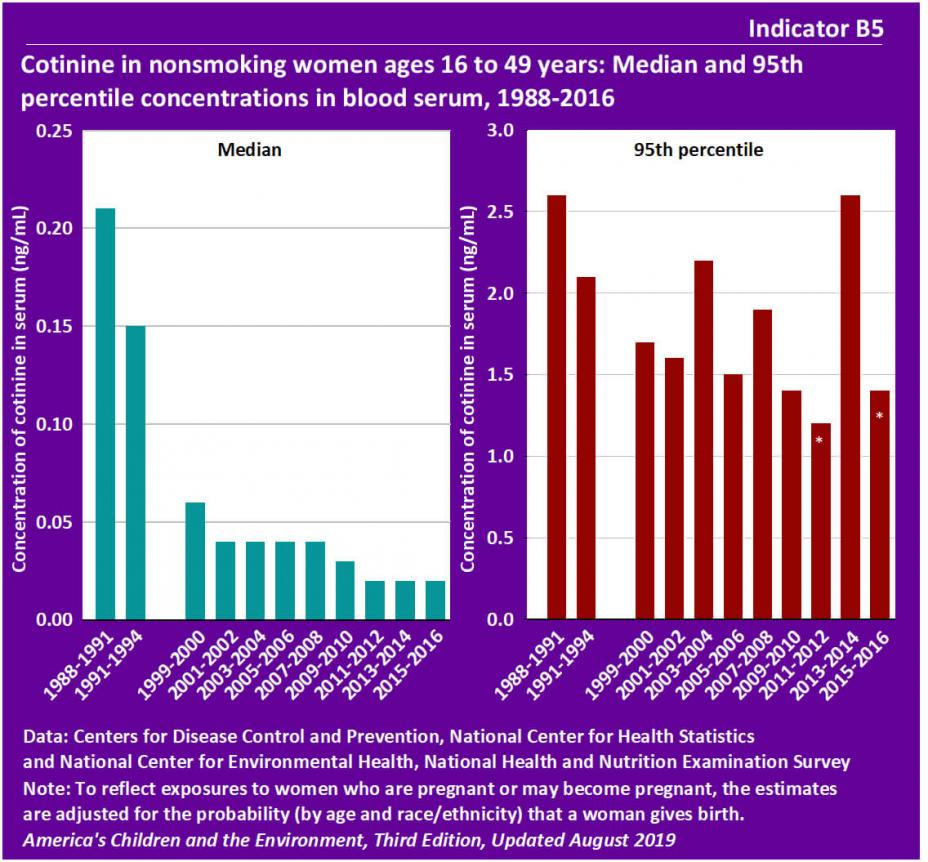ACE: Biomonitoring - Cotinine
Indicators
Indicator B4
![]()

*The estimate should be interpreted with caution because the standard error of the estimate is relatively large: the relative standard error, RSE, is at least 30% but is less than 40% (RSE = standard error divided by the estimate), or the RSE may be underestimated.
Data characterization
- Data for this indicator are obtained from an ongoing continuous survey conducted by the National Center for Health Statistics.
- Survey data are representative of the U.S. civilian noninstitutionalized population.
- Cotinine is measured in blood samples obtained from individual survey participants.
- The median level of cotinine measured in blood serum of nonsmoking children ages 3 to 17 years dropped from 0.25 ng/mL in 1988–1991 (ages 4 to 17 years) to 0.03 ng/mL in 2015–2016, a decrease of 88%. This decreasing trend was statistically significant.
- Cotinine values at the 95th percentile decreased by 50% from 1988–1991 to 2015–2016. This trend was also statistically significant.
- Children at the 95th percentile of cotinine levels had much higher levels than those at the median. In 1988–1991, the 95th percentile cotinine level (3.2 ng/mL) was 13 times the median level (0.25 ng/mL); in 2015–2016, the 95th percentile cotinine level (1.6 ng/mL) was 53 times the median level (0.03 ng/mL).
- In every time period measured except for 2013-2014, children at the 95th percentile had higher levels of cotinine in their blood than women at the 95th percentile. (Compare with Indicator B5.)
- Eighty-seven percent of nonsmoking children ages 4 to 17 years had detectable levels (at or above 0.05 ng/mL) of cotinine in 1988–1991. Thirty-six percent of nonsmoking children ages 3 to 17 years had levels at or above 0.05 ng/mL of cotinine in 2015–2016, although improvements in laboratory methods made it possible to detect cotinine at lower concentrations starting with the 2001–2002 survey cycle. (Data not shown.)
- In 2013–2016, median concentrations of cotinine in blood for nonsmokers were approximately 0.12 ng/mL for Black non-Hispanic children, 0.02 ng/mL for White non- Hispanic children, and 0.02 ng/mL for Mexican-American children. The differences between Black non-Hispanic children and both White non-Hispanic children and Mexican-American children were statistically significant. (See Table B4a.)
- In 2013–2016, the median concentration of cotinine in blood serum for nonsmoking children living below the poverty level (0.07 ng/mL) was about 4 times the median for nonsmoking children living at or above the poverty level (0.02 ng/mL). The differences between income groups were statistically significant. (See Table B4a.)
- In 2013–2016, 95th percentile concentrations of cotinine in blood for nonsmokers were 1.9 ng/mL for White non-Hispanic children and 3.5 ng/mL for Black non-Hispanic children, while Mexican-American children had levels that were more than 3 times lower (0.6 ng/mL). (See Table B4b.)
- The differences between levels for these race/ethnicity groups were statistically significant.
- For the years 2013–2016, there were no significant differences between children’s age groups in median levels of cotinine. (See Table B4c.)
Indicator B5
![]()

*The estimate should be interpreted with caution because the standard error of the estimate is relatively large: the relative standard error, RSE, is at least 30% but is less than 40% (RSE = standard error divided by the estimate), or the RSE may be underestimated.
Data characterization
- Data for this indicator are obtained from an ongoing continuous survey conducted by the National Center for Health Statistics.
- Survey data are representative of the U.S. civilian noninstitutionalized population.
- Cotinine is measured in blood samples obtained from individual survey participants.
- The median level of cotinine measured in blood serum of nonsmoking women of child-bearing age dropped from 0.21 ng/mL in 1988–1991 to 0.02 ng/mL in 2015–2016, a decrease of 90%. This decreasing trend was statistically significant.
- Cotinine values at the 95th percentile decreased by 46% from 1988–1991 to 2015–2016. This trend was also statistically significant.
- Women at the 95th percentile cotinine levels had much higher levels than those at the median. In 1988–1991, the 95th percentile cotinine level (2.6 ng/mL) was 12 times the median level (0.21 ng/mL); in 2015–2016, the 95th percentile cotinine level (1.4 ng/mL) was 70 times the median level (0.02 ng/mL).
- In 2013–2016, median concentrations of cotinine in blood for nonsmoking women were approximately 0.09 ng/mL for Black non-Hispanic women, 0.02 ng/mL for White non- Hispanic women, and 0.01 ng/mL for Mexican-American women (See Table B5a).
- The differences between Black non-Hispanic women and Mexican-American women were statistically significant.
- Cotinine values at the 95th percentile were three times higher for nonsmoking women living below the poverty level (4.1 ng/mL) than for nonsmoking women living at or above the poverty level (1.3 ng/mL) in 2013–2016. The differences between income groups were statistically significant. (See Table B5b.)
Background Text
About the Cotinine Indicators
Indicators B4 and B5 present information about cotinine levels measured in children and women. Cotinine is a marker of exposure to environmental tobacco smoke (ETS), commonly referred to as secondhand smoke. The data are from a national survey that collects blood specimens from a representative sample of the population every two years, and then measures the concentration of various contaminants in the blood. These indicators focus on both children and women of child-bearing age because of concern for potential adverse effects in children exposed to ETS and in children born to women who have been exposed to ETS.
ETS is a complex mixture of gases and particles and includes smoke from burning cigarettes, cigars, and pipe tobacco, as well as exhaled smoke. Children can be exposed to ETS in their homes or in places where people are allowed to smoke, such as some restaurants in some locations throughout the United States.
According to the U.S. Surgeon General, there is no safe level of exposure to ETS, and breathing even a small amount can be harmful to human health. The Surgeon General has concluded that exposure to ETS causes sudden infant death syndrome (SIDS), acute lower respiratory infections, ear problems, and more severe asthma in children. Exposure to ETS causes respiratory symptoms and slows lung growth in children. The exposure of a pregnant woman to ETS can also be harmful to her developing fetus. The Surgeon General has determined that exposure of pregnant women to ETS causes a small reduction in mean birth weight and the evidence is suggestive (but not sufficient to infer causation) of a relationship between maternal exposure to environmental tobacco smoke during pregnancy and preterm delivery.
Indicators B4 and B5 present cotinine levels measured in blood serum of women and children from the National Health and Nutrition Examination Survey (NHANES) as a marker of exposure to ETS.
More information about cotinine and Indicators B4 and B5 is provided in the updated Cotinine section of America's Children and the Environment, Third Edition.
Related Links
Centers for Disease Control and Prevention (CDC): Health Effects of Secondhand Smoke
National Cancer Institute (NCI): Secondhand Smoke and Cancer
National Toxicology Program (NTP): Tobacco-Related Exposures
U.S. EPA: Health Effects of Exposure to Secondhand Smoke
Methods
Summary of Methods - Cotinine
The National Center for Health Statistics, a division of the Centers for Disease Control and Prevention, conducts the National Health and Nutrition Examination Surveys (NHANES), a series of U.S. national surveys of the health and nutrition status of the noninstitutionalized civilian population. Interviews and physical examinations are conducted with approximately 10,000 people in each two-year survey cycle. The survey measures cotinine levels in blood serum samples collected from NHANES participants.
Indicator B4 uses the NHANES data to present median and 95th percentile concentrations of cotinine measured in blood serum of nonsmoking children ages 3 to 17 years (ages 4 to 17 for 1988-1994). Indicator B5 uses the NHANES data to present median and 95th percentile concentrations of cotinine measured in blood serum of nonsmoking women ages 16 to 49 years. Both indicators present cotinine levels for non-tobacco-users only.
Detailed Methods for Indicators B4 and B5
Metadata for National Health and Nutrition Examination Survey (NHANES)
